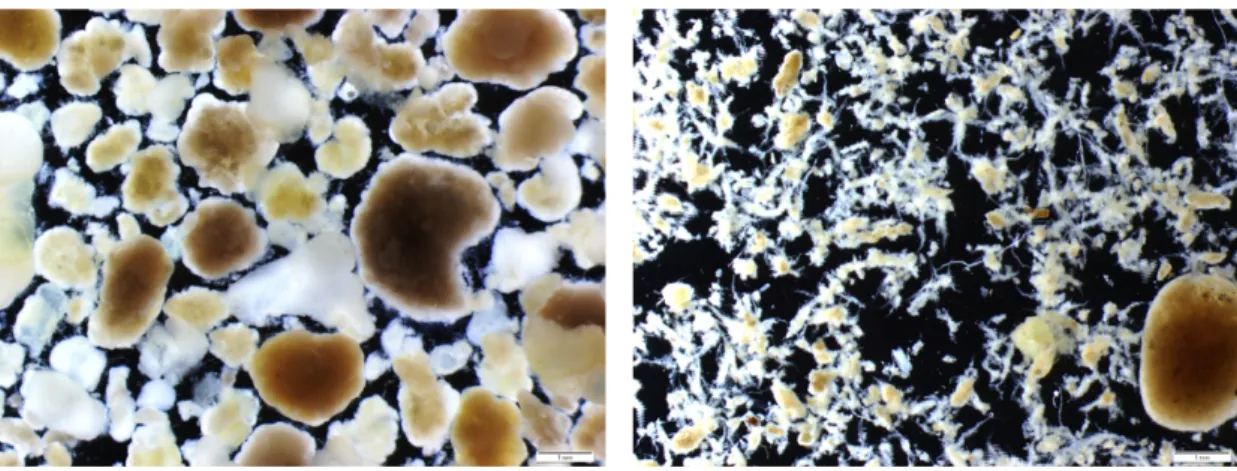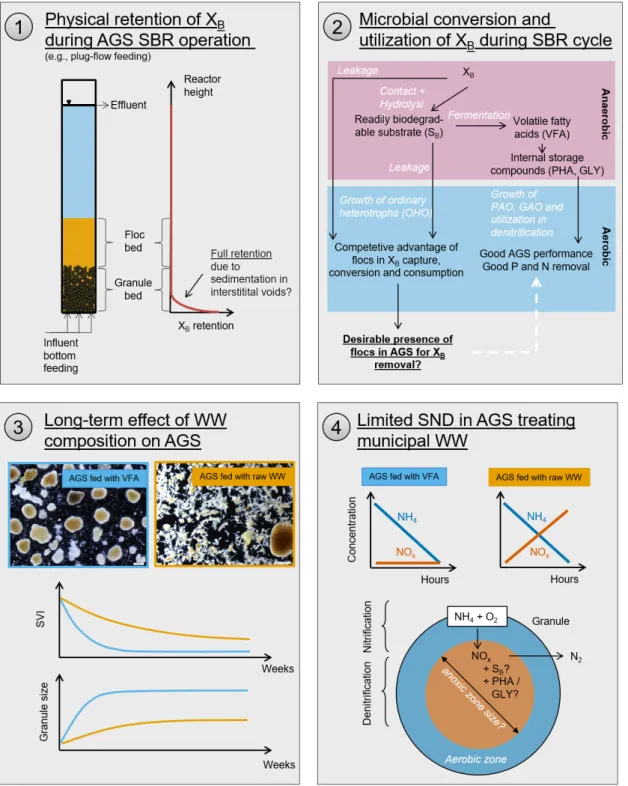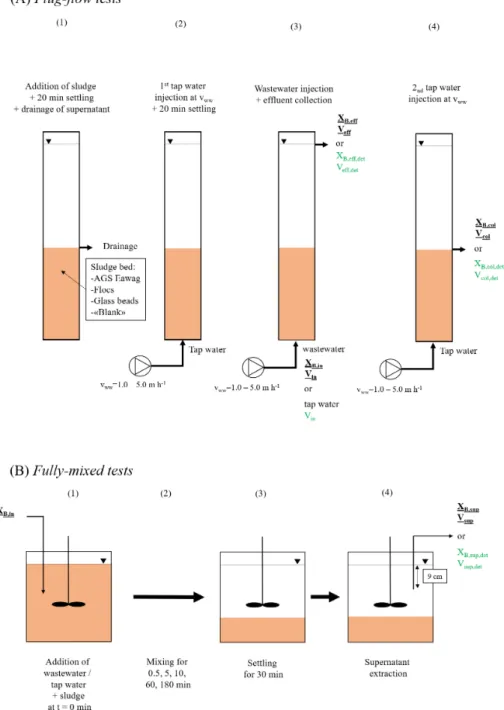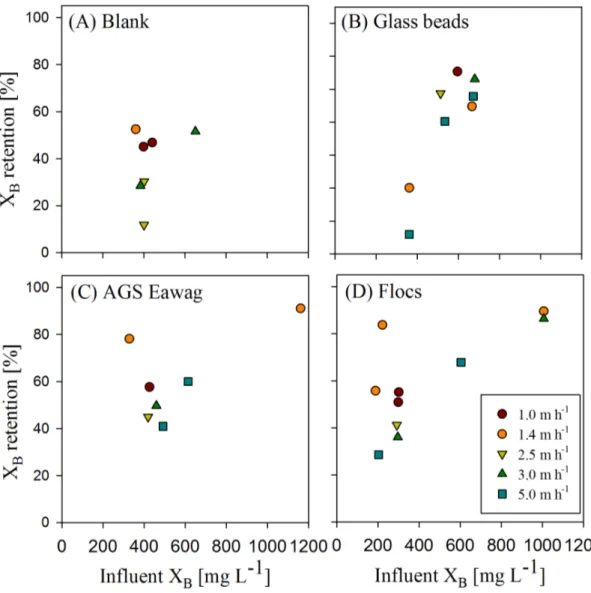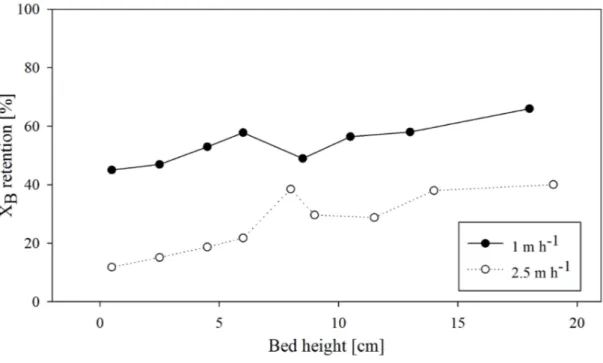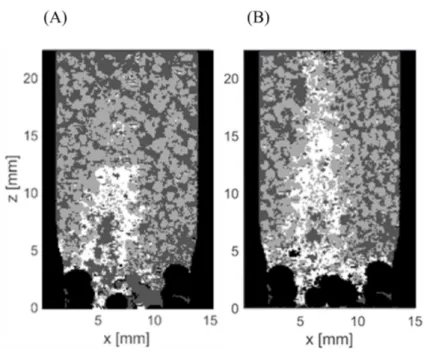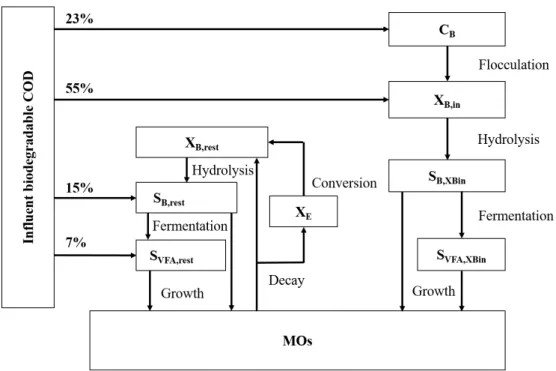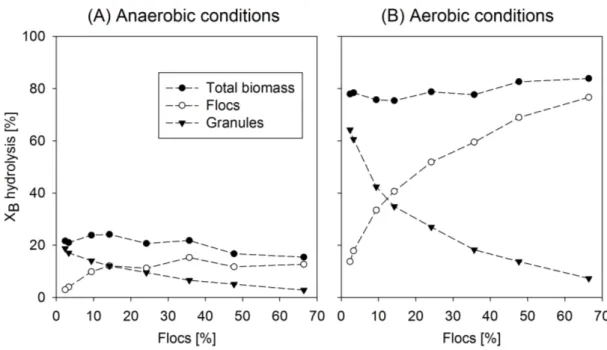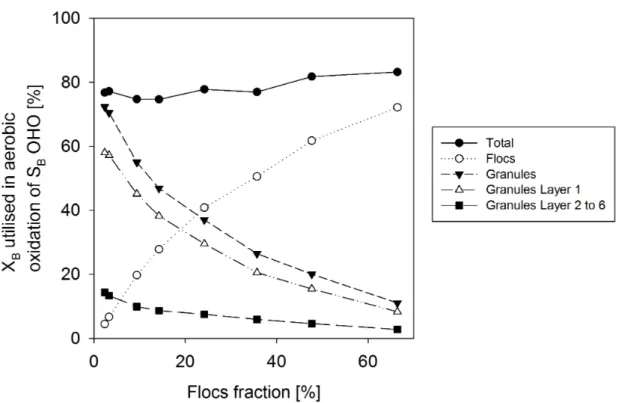Research Collection
Doctoral Thesis
The effect of particulate organic substrate on the formation, composition and performance of aerobic granular sludge
Author(s):
Layer, Manuel Publication Date:
2021
Permanent Link:
https://doi.org/10.3929/ethz-b-000474564
Rights / License:
In Copyright - Non-Commercial Use Permitted
This page was generated automatically upon download from the ETH Zurich Research Collection. For more information please consult the Terms of use.
The effect of particulate organic substrate on the formation,
composition and performance of
aerobic granular sludge
DISS. ETH NO. 27048
The effect of particulate organic substrate on the formation, composition and performance of
aerobic granular sludge
A thesis submitted to attain the degree of
DOCTOR OF SCIENCES of ETH ZURICH (Dr. sc. ETH Zürich)
Presented by Manuel Layer MSc. ETH Zurich
born 06.02.1990 citizen of
Federal Republic of Germany
accecpted by the recommendation of Prof. Dr. Eberhard Morgenroth
Dr. Nicolas Derlon Prof. Dr. Christof Holliger
Kim Sörensen Edward van Dijk
2021
Abstract
Today, aerobic granular sludge (AGS) technology is an established alternative to con- ventional activated sludge for the biological treatment of municipal wastewater (WW).
But despite countless studies and full-scale applications of AGS, the effect of partic- ulate organic substrate (X
B) - the major constituent of organic substrate in munici- pal WW - on AGS start-up, performance, stability and microbial community is not well understood. Therefore this PhD thesis evaluated physical retention and microbial turnover pathways of X
Bduring AGS sequencing batch reactor (SBR) operation, as well as the influence of X
Bon formation, process stability, settling performance, nutri- ent removal and microbial community composition of AGS systems.
Physical retention of X
Bduring AGS-SBR operation was identified as a 2-step pro-
cess. Firstly, X
Bsedimented and accumulated in the bottom of the settled sludge
bed and was retained through surface filtration by the emerging filter-cake. Thus, at-
tachment to biomass was quite limited. Secondly, X
Bthen was preferentially attach-
ing to the flocs during fully-mixed conditions. Results from mathematical modelling
of X
Bhydrolysis, conversion and turnover resembled and expanded those prior find-
ings. Flocs played a major role in aerobic X
Butilisation via aerobic oxidation by or-
dinary heterotrophic organisms (OHO). Synergies between flocs and granules were
observed, where flocs diverted aerobic X
Boxidation from the granules and thus sup-
ported anaerobic-feast aerobic-famine conditions for the granules, despite the minor
mass fraction of flocs. Long-term operation of AGS systems fed with different WW
additionally reinforced the results from physical X
Bretention experiments and mathe-
matical modelling. Complex WW composed of low volatile fatty acids (VFA) and high
X
Bfractions led to the formation of small granules and 10-40 % ( % of total suspended
solids) of flocs as well as to increased start-up time, decreased nutrient removal and
settling performance. The microbial community of AGS treating WW composed of
X
Bwas characterised by a high abundance of fermenting bacteria, like fermentative
glycogen and phosphorus accumulating organisms (fGAO, fPAO, respectively). Simul-
taneous nitrification-denitrification (SND) was quite limited when AGS was fed with
municipal WW containing X
B. The main factors influencing SND in those AGS sys-
tems were identified to be the dynamic of anoxic formation and decay inside the gran-
ule and the availability of organic substrate in the anoxic granule layers. In addition,
the PhD thesis could significantly contribute towards practical understanding of AGS
for the treatment of municipal WW. Most importantly, AGS was distinguished as hy-
brid biofilm system, whereby biofilm (granules) and suspended growth (flocs) coexisted
in synergy. Optimised aeration strategies such as intermittent aeration were identi-
fied to increase SND and total nitrogen removal by AGS systems fed with municipal
WW significantly. Overall, AGS proved to be a simple, efficient and stable process for
the treatment of municipal WW. However, expectations towards settleability, start-up
duration and nutrient removal performance must be lowered if AGS is applied for the
treatment of low-strength municipal WW containing X
B.
Zusammenfassung
Aerob granulierter Belebtschlamm (AGS) ist eine relativ neue Alternative zum kon- ventionellen Belebtschlammverfahren in der biologischen Abwasserreinigung. Trotz zahlreicher Studien und Anwendungen im Vollmassstab von AGS wurde der Effekt von partikulärem Substrat (X
B), welcher den Hauptanteil an organischem Substrat in kommunalem Abwasser darstellt, noch nicht ausreichend untersucht. Die Zielset- zung der vorliegenden Doktorarbeit war es deshalb, den physischen Rückhalt und die mikrobielle Verwertung von X
Bim AGS Sequencing-Batch-Reaktor (SBR) Betrieb zu erforschen. Zusätzlich wurde der Einfluss von X
Bauf die Bildung, Prozessstabilität, Absetzbarkeit, Nährstoffentfernung und mikrobielle Gemeinschaft von AGS analysiert.
Der physische Rückhalt von X
Bim AGS SBR wurde als zweistufiger Prozess identi-
fiziert. Während der Beschickung im «Plug-Flow» wurde X
Bhauptsächlich am Bo-
den des Reaktors durch Oberflächenfiltration im Porenraum des abgesetzten Schlamm-
betts, welches vor Allem aus Granula besteht, zurückgehalten. Der Kontakt zwischen
X
Bund AGS und damit der Stoffumsatz waren dadurch stark limitiert. Sobald der
Reaktor volldurchmischt wurde, adsorbierte X
Bpräferenziell an den Flocken. Diese
Resultate wurden durch mathematische Modellierung des AGS SBR Prozesses bestätigt
und erweitert. Die Flocken spielten eine wichtige Rolle im Rückhalt, der Hydrolyse
und der mikrobiellen Verwertung von X
B. Flocken leiteten die mikrobielle Verwertung
von X
Bweg von den Granula, obwohl Flocken nur einen kleinen Teil an der Gesamt-
biomasse ausmachten. Langzeitversuche zeigten weiter auf, dass niedrige Anteile an
volatilen Fettsäuren zusammen mit X
Bim Zulauf zu einem erhöhten Anteil an Flocken
führten (10-40% an suspendierten Feststoffen), die Dauer zur Bildung von Granula
deutlich erhöhten, sowie zu einer Verschlechterung der Nährstoffentfernung und Abset-
zverhalten führten. Fermentierende Bakterien wie fermentierende Glykogen- und Phos-
phor akkumulierende Bakterien (fGAO, fPAO) dominierten die mikrobielle Gemein-
schaft in Gegenwart von X
Bim Zulauf. Die simultane Nitrifikation-Denitrifikation
(SND) war stark beeinträchtigt, sobald AGS zur Reinigung von kommunalem Ab-
wasser eingesetzt wurde. Die limitierenden Faktoren der SND waren die Dynamik der
Bildung und des Verfalls der anoxischen Zonen im Inneren der Granula, sowie die Ver-
fügbarkeit von organischem Substrat in den anoxischen Zonen. Die vorliegende Dok- torarbeit konnte des Weiteren wichtige Erkenntnisse für den praktischen Betrieb von AGS Systemen zur Reinigung von kommunalem Abwasser bereitstellen. AGS wird als
«Hybrid-Biofilm» Verfahren anerkannt, in welchem Flocken und Granula in Synergie
koexistieren. Des Weiteren konnte aufgezeigt werden, dass die Stickstoffentfernung
von AGS Prozessen mithilfe optimierter Belüftungsstrategien (z.B. intermittierender
Belüftung) signifikant erhöht werden kann. Abschliessend erwies sich AGS als stabiles,
effizientes und simples Verfahren zur biologischen Reinigung von kommunalem Ab-
wasser. Die Erwartungen an die Sedimentationsleistung, Dauer zur Bildung von Gran-
ula und Nährstoffentfernung müssen jedoch gedämpft werden, falls AGS zur Reinigung
von stark verdünntem, X
B-reichem kommunalem Abwasser eingesetzt wird.
Acknowledgement
First and foremost I want to thank my supervisor Nicolas Derlon and my advisor Eber- hard Morgenroth. Your patience, feedback, sharp minds and positive attitude towards work and life had significant influence on the success of my PhD and you had a very positive impact on my personal development during this time, too. Eberhard, your lec- tures and enthusiasm sparked my interest in biological wastewater treatment and pro- cess engineering during my Master studies, which left me with no choice but to con- duct a PhD with you. Nico, your enthusiasm and excitement about granules, biofilms, reactor operation and process engineering in general is contagious and the best moti- vation and foundation for research I can imagine.
Furthermore, I would like to thank all my students, who conducted their Master’s Thesis under my main- or co-supervision: Eva Reynaert, Antonio Hernandez, Antoine Brison, Franziska Golz, Kristina Bock and Matthias Stähle. Also, two students con- ducting their Master’s Thesis before or during the start of my PhD also significantly contributed to the success of my PhD: Michael Cunningham and Mercedes Garcia, the latter of which later became a colleague and contributed even more towards my PhD.
Your contributions and critical feedback had significant influence on the success of my PhD and my personal development during the PhD.
Chapter 4 of my PhD was set-up, executed, and written in close and fruitful collabora- tion with EPFL. I would like to thank Aline Adler and Christof Holliger and everyone else involved in this project for their contribution, critical feedback and patience. Also, I would like to thank Arnaud Gelb, who helped with microbial community analysis and interpretation in other projects countless times.
In the process engineering department, I would specifically thank Marco Kipf, Richard
Fankhauser, Adriano Joss, Karin Rottermann, Sylvia Richter, Jacqueline Traber, Brian
Sinnet, Canan Aglamaz and Ariane Eberhardt who were directly or indirectly involved
with my experimental, lab, or office work.
The PhD groups of the process engineering (ENG) and urban water management (SWW) departments of Eawag always were a great source of inspiration, very criti- cal feedback and overall great atmosphere and motivation. Thanks to Michele Lau- reni, Ann-Kathrin McCall, Peter Desmond, Lena Mutzner, Christian Thürlimann, Jonas Wielinski, Wenzel Gruber, Bruno Hadengue, Mariane Schneider, Isabell Köp- ping, Natalia Duque, Angelika Hess, Damian Hausherr, Antoine Brison, Matthew Moy de Vitry, Stanley Sam, Barbara Jeanne Ward, Liliane Manny, Valentin Faust, Cassio Schambeck, Omar Wani, Abishek Narayan and Aurea Heusser.
I also want to thank my office mates, who were always a great source inspiration and motivation in hard times, endured my sometimes bad but mostly enthusiastic mood and overall made me a better human being after four joint years: Michel Riechmann, Wenzel Gruber, Carina Doll, Andy Disch, Hans-Peter Zöllig, Antoine Brison, Valentin Faust, Xiaobin Tang, Livia Britschgi and Simon Obrecht.
I am grateful to all my family and friends who supported me during my PhD, which was to be the most challenging time of my life so far. Thank you so much Frieda. You were born right after I started my PhD and now you are almost four years old! You are the most welcome distraction I could ever imagine. Thank you Jule for being a great mother and support during my PhD. Lena, I am so thankful for support, pa- tience and source of inspiration especially during the last few months of my PhD and for life in general.
I cannot thank you all enough for this.
Manu
Contents
Abstract
v
Zusammenfassung
vii
Acknowledgement
x
Contents
xii
1 Introduction
2
1.1 Municipal wastewater treatment . . . . 2
1.2 From activated sludge to advanced biofilm reactors . . . . 3
1.3 The composition of municipal wastewater . . . . 4
1.4 Aerobic granular sludge (AGS) systems . . . . 5
1.4.1 Discovery and definition of AGS . . . . 5
1.4.2 Mechanisms involved in the formation of AGS . . . . 6
1.4.3 AGS for the treatment of municipal wastewater . . . . 7
1.5 Objectives . . . 14
1.6 Thesis outline . . . 14
1.7 References . . . 16
2 Particulate substrate retention in plug-flow and fully-mixed conditions dur- ing operation of aerobic granular sludge systems
24 2.1 Abstract . . . 24
2.2 Introduction . . . 25
2.3 Materials and Methods . . . 28
2.3.1 Experimental approach . . . 28
2.3.2 Experimental set-up . . . 28
2.3.3 Magnetic Resonance Imaging (MRI) . . . 33
2.4 Results . . . 34
2.4.1 Retention of X
Bduring the anaerobic plug-flow feeding of AGS
systems . . . 34
2.4.2 How is X
Bretained in fully-mixed conditions? . . . 37
2.5 Discussion . . . 39
2.5.1 X
Baccumulates within the sludge bed during plug-flow feeding but does not attach to granules . . . 39
2.5.2 Large fractions of X
Bare retained by flocs during fully-mixed conditions . . . 42
2.5.3 Practical implications . . . 43
2.6 Conclusions . . . 44
2.7 Acknowledgements . . . 45
2.8 References . . . 46
3 Pathways of microbial particulate substrate utilisation during anaerobic plug-flow feeding and aerobic fully-mixed conditions in aerobic granular sludge operation
52 3.1 Abstract . . . 52
3.2 Introduction . . . 53
3.3 Materials and Methods . . . 54
3.3.1 Mathematical modelling . . . 54
3.3.2 Calculations . . . 61
3.3.3 Sensitivity analysis . . . 62
3.4 Results . . . 63
3.4.1 How much X
Bis hydrolysed in anaerobic vs. aerobic conditions and what is the contribution of flocs? . . . 63
3.4.2 What is the role of flocs in X
Bhydrolysis? . . . 63
3.4.3 What are the main microbial conversion pathways of X
B? . . . 64
3.4.4 To what extent can operating conditions be optimised to en- hance anaerobic X
Butilisation in AGS-SBR operation? . . . 69
3.4.5 Sensitivity analysis . . . 70
3.5 Discussion . . . 71
3.5.1 X
Bis a disadvantageous organic substrate in AGS systems . . . . 71
3.5.2 Flocs play a major role in X
Bconversion and utilisation in AGS systems . . . 72
3.5.3 How can anaerobic X
Butilisation be enhanced in AGS-SBR op-
eration? . . . 73
3.5.4 Modelling limitations and outlook . . . 74
3.6 Conclusions . . . 75
3.7 Acknowledgements . . . 76
3.8 References . . . 77
4 Organic substrate diffusibility governs microbial community composition, nutrient removal performance and kinetics of granulation of aerobic granu- lar sludge
84 4.1 Abstract . . . 84
4.2 Introduction . . . 85
4.3 Materials and methods . . . 88
4.3.1 Experimental approach . . . 88
4.3.2 Experimental set-up . . . 88
4.3.3 Start-up approach . . . 89
4.3.4 Start-up definition . . . 89
4.3.5 Wastewater composition and sludge inoculum . . . 90
4.3.6 Physical sludge parameters . . . 92
4.3.7 Analytical methods . . . 92
4.3.8 Microbial community analysis . . . 92
4.4 Results . . . 94
4.4.1 Settling properties . . . 94
4.4.2 Sludge size fractions . . . 95
4.4.3 Evolution of the bacterial community composition from inocula- tion to stable state . . . 97
4.5 Bacterial communities of granules and flocs . . . 101
4.5.1 Nutrient removal performance . . . 103
4.5.2 Correlations between settling properties, nutrient-removal perfor- mances and microbial community composition . . . 103
4.5.3 Identification of correlations between the discriminant taxa and the sludge size distributions, the settling properties, and the nutrient-removal performances. . . 105
4.6 Discussion . . . 108
4.6.1 Diffusibility of organic substrates has significant influence on for- mation of AGS . . . 108
4.6.2 Start-up . . . 109
4.6.3 Steady-state . . . 111
4.6.4 The role of flocs in AGS systems . . . 113
4.6.5 Implications for research and practice . . . 114
4.7 Conclusions . . . 115
4.8 Acknowledgments . . . 116
4.9 References . . . 117
5 Limited simultaneous nitrification-denitrification (SND) in aerobic granular sludge systems treating municipal wastewater: Mechanisms and practical implications
126 5.1 Abstract . . . 126
5.2 Introduction . . . 127
5.3 Materials and Methods . . . 130
5.3.1 Experimental approach and reactor configuration . . . 130
5.3.2 Modelling . . . 132
5.3.3 Calculations . . . 136
5.3.4 Analytical methods . . . 137
5.4 Results . . . 137
5.4.1 How is SND influenced by WW composition during long-term operation? (experimental results) . . . 137
5.4.2 How does DO concentration affect SND performance? (experi- mental and modelling results) . . . 137
5.4.3 Dynamics of redox zone formation (modelling results) . . . 139
5.4.4 Which electron donors are actually used for NO
x-N removal? (modelling results) . . . 141
5.4.5 Is there potential for electron-donor shift towards anoxic utilisa- tion pathways? (modelling results) . . . 141
5.4.6 Can SND and TN removal be improved by optimising the aera- tion strategy? (modelling results) . . . 145
5.5 Discussion . . . 145
5.5.1 SND and TN removal is limited in AGS systems treating munici- pal WW . . . 145
5.5.2 What mechanisms limit SND in AGS systems treating municipal WW? . . . 149
5.5.3 How to optimise for TN removal in AGS systems? . . . 151
5.6 Conclusions . . . 153
5.7 Acknowledgements . . . 154
5.8 References . . . 155
6 Conclusions
161
7 Outlook163 7.1 Is AGS suitable for the treatment of municipal wastewater? . . . 163
7.2 AGS vs. established systems for the treatment of municipal wastewater . 165 7.3 AGS in continuous flow systems . . . 166
7.4 Modelling of AGS systems . . . 167
7.5 What is the role of flocs in AGS systems? . . . 167
7.6 References . . . 169
Appendix 175
A Supplementary Information: Chapter 2175 A.1 Sludge images . . . 175
A.2 Calculation of velocity gradient (G) for jar tests . . . 176
A.3 Image processing and analysis of 3D MRI images . . . 177
A.4 Flocs / granules number and surface area calculations . . . 177
B Supplementary Information: Chapter 3
179 B.1 Distribution of granules and flocs during AGS SBR operation . . . 179
B.2 Kinetic model . . . 179
B.3 S
VFAstorage kinetics of PAO and GAO . . . 180
B.4 Microbial community composition of the default scenario . . . 181
C Supplementary Information: Chapter 4
182
D Supplementary Information: Chapter 5196 D.1 SND efficiency calculation from literature . . . 196
D.2 AGS model description . . . 205
D.2.1 Sumo Biofilm Model . . . 205
D.2.2 Biokinetic Model . . . 206
D.2.3 Reactor Model . . . 206
E References
210
Curriculum Vitae 213
Publications 215
1. Introduction
1.1. Municipal wastewater treatment
The treatment of municipal wastewater (WW) is often referred to as the most impor- tant development in human health of the last two centuries (Henze et al., 2008). Its introduction became necessary, whenever the “capacity of a river for self-purification”
(Jenkins and Wanner, 2014) was exceeded, which was especially the case in densely populated areas, and led to hygienic and ultimately human health problems. The ini- tial goals of municipal WW treatment were therefore to purify water in order to limit risks towards humans and ensure hygiene (Henze et al., 2008). During the 1970s the goals of WW treatment were extended in order to protect the downstream users of water and the aquatic environment (Jenkins and Wanner, 2014), and ultimately to today’s immission control, which incorporates potentially harmful impacts on human beings and their environment (Umweltbundesamt, 2020). Today, wastewater treatment plants (WWTP) have to fulfil ever increasing treatment requirements, such as reaching very low effluent concentrations of nitrogen (N) and phosphorus (P) compounds, with a simultaneous minimization of space requirements, energy usage and greenhouse gas (GHG) emissions or recovery of valuable resources ( e.g. , N, P) from WW streams. The transition from WWTP, which remove pollutants from human waste streams, towards water resource recovery facilities (WRRF), which produce valuable goods such as clean water and nutrients, is therefore required.
Today, WWTP typically consists of 3 treatment steps: primary (mechanical / physi-
cal), secondary (biological) and tertiary (filtration, disinfection, advanced oxidation)
treatment. Primary treatment consists of mechanical pre-treatment and is typically
constituted of fat and grit-removal, as well as primary sedimentation, which removes
a large part of settleable solids and organics, sand, fat and other coarse fractions from
WW. The subsequent secondary treatment is a biological treatment step. The over-
whelming majority of biological WW treatment today is accomplished by utilising
the so-called “activated sludge” process, whereby microorganisms are cultivated to re-
move or convert organics and nutrients from WW, first published by Ardern and Lock-
ett, 1914. The growth of those microorganisms occurs in the suspended phase, i.e. , in
the form of activated sludge flocs. Activated sludge flocs are then separated from the
treated WW in the secondary clarifier. In AS WWTP, secondary clarifiers often limit
the treatment capacity of the entire WWTP, since settleability and thus separation
rates of activated sludge and treated WW are low. Different reactor configurations ex-
ist, such as continuous flow systems or sequencing batch reactors (SBR), whereby the
processes of reaction and separation are either separated in time (SBR), or in space
(continuous flow systems). Activated sludge processes can be operated independently from reactor configuration. For a long time, the activated sludge process was solely designed to remove organic substrate (carbon) and pathogens by aerobic oxidation.
Advances in process understanding, design and operation allowed to integrate biologi- cal nitrification (NH
4+to NO
3-) and biological nitrogen removal (nitrification + den- itrification, NH
4+to NO
3-to N
2) within the activated sludge process. Eventually, en- hanced biological phosphorus removal (EBPR) activated sludge integrated within the activated sludge process. Today, many existing WWTP are reaching their maximum capacity. Also, due to urbanisation, it is required to intensify and improve WW treat- ment. Therefore, research is required to identify and evaluate new technologies with improved treatment capacity, lower space requirements and high economic efficiency.
1.2. From activated sludge to advanced biofilm reactors
Biofilm reactors for the treatment of municipal WW have been applied in the form of trickling filters since the early 1900s (Morgenroth, 2008). However, since the 1980 - 1990s more advanced biofilm reactor systems, like submerged biofilm, integrated fixed- film activated sludge (IFAS), membrane bio-reactors (MBR), or moving bed biofilm reactors (MBBR) are widely applied in municipal WW treatment. Biofilms for WW treatment rely on a substratum - a surface material like a membrane, cloth or car- rier material - for attachment and growth, and are oftentimes referred to as “attached growth” in opposition to “suspended growth” as in activated sludge systems. Biofilm reactors promise high volumetric loadings, good effluent quality without requiring solids separation (secondary clarifier) or recirculation (both not in hybrid biofilm - suspended growth systems, like IFAS) resulting in a lower footprint as compared to ac- tivated sludge systems (Rittmann, 1982). The newest addition to aerobic biofilm sys- tems are aerobic granular sludge (AGS) systems, in which the biomass self-immobilises into so-called granules, without relying on a substratum (Beun et al., 1999; Morgen- roth et al., 1997).
In general, aerobic biofilm reactors can achieve similar treatment performance as acti-
vated sludge systems, like organic substrate removal, nitrification, denitrification and
EBPR (Morgenroth, 2008). The main difference between activated sludge and biofilm
WW treatment is that mass-transport of substrate (electron-donor and electron-acceptor)
is limited by diffusion in biofilms. Limited mass-transport has vast impacts on micro-
bial ecology, reactor operation and design (Morgenroth, 2008). Mass-transport limita-
tions - in theory - allow for simultaneous nutrient removal processes like simultaneous
nitrification - denitrification (SND) (Falkentoft et al., 1999; Hibiya et al., 2004; Nielsen et al., 1990).
Besides aerobic biofilms, also anaerobic biofilm systems for municipal or industrial WW treatment exist. Such systems include anaerobic filters (AF), upflow anaerobic sludge blankets (UASB) or integration of anammox technology in a biofilm environ- ment (either through attached-growth or as anammox granules) (Arrojo et al., 2006;
McHugh et al., 2003; Tsushima et al., 2007). Biomass in UASB or anammox granular reactors consist of granular biofilms, which self-immobilise (without requiring a sub- stratum) (Lettinga, 2001), similar to AGS technology.
However, despite many full-scale applications of advanced biofilm systems for the treat- ment of municipal WW, the majority of WWTP worldwide operates as activated sludge system. Further research and improvement of advanced biofilm systems is therefore re- quired in order to intensify and improve treatment of municipal WW.
1.3. The composition of municipal wastewater
Municipal WW is a complex mixture of organic and inorganic pollutants and differen- tiates from other WW streams ( e.g. , industrial WW, stormwater) by its heterogeneity in terms of composition and typically low concentration ranges (resulting from high di- lution). Municipal WW is composed of microorganisms (pathogens, bacteria, viruses, etc. ), biodegradable and other organic materials (organic substrate, carbonaceous com- pounds), macro- and micronutrients (nitrogen (N), phosphorus (P), etc. ), as well as metals and other inorganic materials (Cu, Zn, acids, bases, etc. ) (Henze et al., 2008).
Organic substrate, the main pollutant in municipal WW, is typically characterised by the sum parameters chemical oxygen demand (COD) or biological oxygen demand (BOD). COD can be differentiated in terms of physical properties (material size) be- tween total, soluble (sCOD, after filtration at 0.45 µ m), and particulate (pCOD, total minus soluble COD) fractions. COD can also be differentiated in terms of biological availability between readily biodegradable COD (rbCOD), slowly biodegradable COD (sbCOD) and inert (unbiodegradable) COD. Another important measure of organic substrate is BOD. BOD indicates a highly biodegradable fraction of organic substrate and is typically measured after 5 days of aerobic degradation (BOD
5). Volatile fatty acids (VFA) are a fraction of organic substrate with very high biodegradability, specifi- cally, acetate (Ac) and propionate (Pr). VFA are part of BOD
5and rbCOD. Availabil- ity of rbCOD is essential for EBPR (Gerber et al., 1986).
Particulate and sbCOD are both proxies for polymeric organic substrate, or sheer par-
ticles, both referred to as X
B, contrary to readily biodegradable organic substrate (S
B). X
Btypically represents > 50 % of organic substrate in the influent WW (mea- sured as COD) (Metcalf and Eddy, 2014), but the specific composition in terms of protein, carbohydrate and lipid can vary significantly between different municipal WW (Sophonsiri and Morgenroth, 2004). In opposition to monomeric organic substrate (S
B), X
Bcannot be transported through the cell envelope of microorganisms due to its size larger than 10
3amu. Therefore, organic substrate polymers have to be trans- formed into monomers by hydrolysis – enzymatic depolymerisation – before microor- ganisms can utilise this type of organic substrate (Morgenroth et al., 2002). Protozoa contribute to the degradation of particulate organic substrate through direct uptake and intracellular degradation. However, it remains unclear, whether protozoa signifi- cantly contribute to X
Bdegradation in biological WW treatment (Morgenroth et al., 2002). In general, it is assumed that hydrolysis rates are reduced in anoxic or anaer- obic redox conditions, in comparison to aerobic redox conditions (Henze and Mladen- ovski, 1991). The reduction could be related to the activity of protozoa, whose typi- cally aerobic-only metabolism would significantly be reduced in anoxic or anaerobic re- dox conditions (Morgenroth et al., 2002). In general, it is assumed that the microbial community and protozoa cultivated within the biological stage of the WWTP carry out hydrolysis. Therefore, hydrolysis by microorganisms is initiated only once physical contact between X
Band the microorganisms has been established. However, research has hypothesised that hydrolytic microorganisms could already be attached to X
Bbe- fore it enters the WWTP, and that only a small fraction of the microorganisms of the WWTP actually contribute to hydrolysis (Benneouala et al., 2017). Due to hydrol- ysis, the rate of biological oxidation of X
Bis typically one order of magnitude lower compared to S
B(Levine et al., 1985), and hydrolysis is often referred to as the rate- limiting step in biological WW treatment (Morgenroth et al., 2002). Understanding and behaviour of X
Bretention, hydrolysis and utilisation is still limited in biological WW treatment, and research is therefore required.
1.4. Aerobic granular sludge (AGS) systems
1.4.1. Discovery and definition of AGS
AGS is a technology for biological WW treatment and composed of self-immobilised
biofilm aggregates without relying on a carrier material (substratum). Granules are
defined as biofilm aggregates of “microbial origin, which do not coagulate under re-
duced hydrodynamic shear, and which settle significantly faster than conventional [ac- tivated] sludge” (de Kreuk et al., 2007). AGS was first discovered and cultivated in two laboratories in Munich and Delft, respectively (Beun et al., 1999; Morgenroth et al., 1997). The minimum size of granules was set to 0.2 mm - 0.25 mm, and high set- tleability of AGS can be expressed as sludge volume indices after 10 and 30 minutes (SVI
10, SVI
30, respectively) being similar: SVI
10≈ SVI
30. High settleability of AGS originates from high settling velocities of 25-70 m h
-1, which is significantly higher than the settling velocity of activated sludge flocs of 7-10 m h
-1(Adav et al., 2008).
1.4.2. Mechanisms involved in the formation of AGS
AGS was first cultivated in SBR by using an aggressive washout strategy on slow set- tling biomass (activated sludge flocs) and relatively high shear force (Beun et al., 1999;
Morgenroth et al., 1997). Since 2000, AGS was studied intensively, and most stud- ies focused on the cultivation of AGS in synthetic WW, mostly composed of readily biodegradable substrates (VFA) (de Kreuk et al., 2007). The fast formation of AGS in such conditions was closely linked to the application of (1) high wash-out stress on slow settling biomass (short settling), (2) application of high shear stress (aeration in- tensity or mixing) and (3) microbial selection through anaerobic-feast - aerobic-famine SBR operation (Adav et al., 2008). AGS fed by synthetic WW can achieve the follow- ing characteristics within 30 days after start-up (de Kreuk et al., 2005; Lochmatter and Holliger, 2014):
(1) Formation of large granules, complete transformation of flocs to granules: diame- ter 0.5-2 mm, granule fraction > 95 %
(2) Excellent settleability: SVI
30< 40 mL g
-1, SVI
30/SVI
10ratio ≈ 1 (3) Simultaneous removal of carbon, nitrogen and phosphorus
Granules form through a gradual transformation process of floccular biomass to com- pact granules, and AGS formation is proposed to include four steps: (1) cell-to-cell attraction by physical, chemical or biochemical forces, (2) microbe-to-microbe attach- ment by hydrodynamic, diffusional and / or thermodynamic forces, (3) microbial ad- hesion enhancement through excretion of extracellular polymeric substances (EPS) and (4) hydrodynamic shear force to stabilise the granule structure (Winkler et al., 2018).
AGS have mainly been cultivated using SBR. Operation of SBR allow for different
operational phases, which were identified as being important for AGS formation and
long-term stability. Feeding of AGS-SBR systems is typically done in plug-flow con- ditions, whereby fresh WW is injected from the bottom into the settled sludge bed, while effluent is withdrawn simultaneously from the top of the reactor (referred to as
“simultaneous fill-draw” mode or “constant volume” operation) (Derlon et al., 2016).
Plug-flow conditions allow for high substrate gradients, which act as driving force for diffusion of substrate into the granules. Anaerobic redox conditions prevail dur- ing feeding and benefit the proliferation and growth of carbon-storing organisms like phosphorus and glycogen accumulating organisms (PAO, GAO, respectively). PAO and GAO demand a key role in AGS formation and stability (de Kreuk and van Loos- drecht, 2004; Winkler et al., 2018). Ideally, all organic substrate is removed through internal carbon-storage during the anaerobic phase by GAO and PAO, respectively. If organic substrate is not fully used up during anaerobic conditions, organic substrate is available in aerobic conditions resulting in aerobic growth of ordinary heterotrophic organisms (OHO), which harm AGS system stability (Sturm et al., 2004). The subse- quent aerobic SBR phase is applied to perform nitrification, EBPR and oxidation or replenishment of internally stored carbon. Afterwards, a short settling period is ap- plied. Excess sludge is removed selectively, i.e. , ideally only slow settling biomass is removed, either after settling (from the sludge fraction still in suspension) or feeding (from the top of the settled sludge bed) (Lochmatter and Holliger, 2014).
1.4.3. AGS for the treatment of municipal wastewater
AGS was first cultivated for the treatment of municipal WW by de Kreuk and van Loosdrecht, 2006. But despite very fast formation and excellent settling properties of AGS in municipal WW conditions, nutrient removal was not satisfactory (Table 1.1).
This early research indicated that the transition of AGS cultivated in the laboratory, typically fed by simple synthetic VFA-rich WW, to cultivation of AGS in municipal WW is quite challenging. Also, operating conditions to achieve granulation as well as mechanisms involved in the formation of AGS might be a function of the influent WW composition.
Nevertheless, Dutch company RoyalHaskoningDHV brought the Nereda
®process to
the market, the first full-scale AGS system for treatment of municipal WW (Giesen et
al., 2013; van der Roest et al., 2011). RoyalHaskoningDHV claims significantly lower
energy and chemical consumption, savings in space, lower investment and operational
costs, as well as simultaneous removal of carbon, nitrogen and phosphorus and overall
excellent treatment performance. Today, over 70 full-scale Nereda
®plants exist, one
being in operation (ARA Alpnach) and one being under construction (ARA Kloten- Opfikon) in Switzerland (Ali et al., 2019; Pronk et al., 2017).
However, further research indicated that expectations towards AGS cultivated in real municipal WW must be lowered in comparison to early lab studies which conducted research on AGS using synthetic VFA-rich WW (Figure 1.1, Table 1.1), specifically:
(1) Much increased start-up time: 20 d up to > 1 year
(2) Decreased settleability: SVI
3040-100 mL g
-1, SVI
30/SVI
10ratio 0.6-1.0 (3) Increased presence of flocs: granule fraction 60-98 %
(4) Limited (simultaneous) nutrient removal performances: incomplete nitrification, incomplete denitrification, increased effluent TN
(5) Distinct morphology of AGS
A literature review on AGS cultivated in municipal WW revealed inconsistencies and wide ranges in applied operational strategies, sludge characteristics and nutrient re- moval performances, indicating that understanding of feasibility, operation and perfor- mance of AGS for the treatment of municipal WW is still limited (Table 1.1). Specifi- cally, many studies cultivated AGS using municipal WW composed of either very high total organic substrate concentrations of 500-1000 mgCOD L
-1, very high fractions of S
B(and hence low X
B), or municipal WW with the addition of VFA. In addition, some studies relied on inoculation with (crushed) AGS or excess sludge from other AGS plants, rather than starting up from activated sludge flocs, which likely signif- icantly decreased start-up time (Linlin et al., 2005; Pijuan et al., 2011; Pronk et al., 2015).
Therefore, one of the main questions is whether AGS can be cultivated without inoc- ulation in municipal WW composed of low S
Band high X
Bconcentrations, typically also referred to as low-strength municipal WW. Further research is therefore required.
Cultivation of AGS in municipal WW is quite challenging (Table 1.1). Operational
strategies to cultivate AGS in lab-scale environments fed by VFA as sole carbon source
were found to be not or only partially applicable in municipal WW conditions. Too
high wash-out stress in municipal WW fed AGS systems results in breakdown of the
nutrient removal performance of AGS systems (Derlon et al., 2016), and high shear-
stress is not required to form AGS in municipal WW (Devlin et al., 2016; Devlin and
Oleszkiewicz, 2018). Researchers therefore focused on and successfully applied the
Figure 1.1.: Morphology after 10 months of operation of 100%-VFA synthetic WW fed AGS (left) and raw WW fed AGS (right) (Layer et al., 2019). Scale bars = 1 mm.
strategy of microbial selection (via anaerobic-feast aerobic-famine SBR operation) in
combination with increased, but not very high washout stress (via short settling time)
to cultivate AGS in municipal WW (Bassin et al., 2019; Campo et al., 2020). Micro-
bial selection requires preferentially supporting the growth of slow-growing organisms
like PAO and GAO. The presence of PAO and GAO is ultimately determined by the
amount of biodegradable organic substrate (and ortho-P for PAO) in the influent WW
(Gerber et al., 1986; Wei et al., 2020). Often, both ortho-P and organic substrate con-
centrations are low, especially in Switzerland (Sollfrank and Gujer, 1991). However,
the proliferation of PAO and GAO can be additionally promoted by operational mea-
sures. Such measures include the promotion of full organic substrate uptake during the
anaerobic phase (feast), in order to (1) support the competitive advantage of carbon-
storing organisms over OHO and (2) limit the organic substrate availability in aerobic
conditions to restrict the growth of OHO. One of the key differences between lab-scale
synthetic WW and municipal WW is the presence of non-diffusible X
Bin municipal
WW (like polymeric carbohydrates, proteins, etc. ). The presence of X
Bcould poten-
tially harm anaerobic-feast - aerobic-famine conditions and therefore limit microbial
selection in AGS-SBR operation (de Kreuk et al., 2010; Derlon et al., 2016; Jabari et
al., 2016; Wagner et al., 2015b). For the application of AGS for the treatment of mu-
nicipal WW it is therefore key to understand the effect of X
Bon AGS systems.
Table1.1.:PerformancecharacteristicsofmunicipalWW(MWW)fedAGSsystems,adoptedandextendedfromDerlonetal.,2016 InfluentSubstratecon- centrations [mgCODL-1]
Organic loading [kgCODtot m-3d-1]
SBRoperation (settlingtime [min],vww[m h-1]) Granulation time[d]Settlingprop- erties[SVImL g-1,SVI30/5 ratio]
Granule fractionSizeof granules [mm]
Effluentquality [mgL-1]InoculumReference MWW (China)CODtot:95-200 CODsol:35-1200.6-1Variablevol- ume300SVI30:40 Ratio:180%0.2-0.8
NH4-N0.5 NO3-N:4 PO4-P:0.5 TSS:15
Nietal., 2009 MWW (40%)and industrial WW (60%) (China)
CODsol250-1800Variablevol- ume400SVI30:<50 Ratio:180-90%0.35Liuetal., 2010 MWW (40%)and indus- trialWW (60%) (Singa- pore)
CODsol1000Variablevol- ume(settling 2-10min)
48
SVI30:30-120 (fluctuating,then stabilisingat <50) Ratio:1
75%2.25NH4-N:0 NO3-N:8Liuetal., 2011 MWW (South Africa)
CODtot:1265Constant volumeSVI30:<50
NH4-N:<2.0 TN:14 TP:5 TSS:<10
Giesenetal., 2013;van derRoest etal.,2011 MWW+ industrial WW(The Nether- lands)
Constant volume400SVI30:40 Ratio:0.6690%
NH4-N0.5 NO3-N:2-4 PO4-P:0.5 TSS:10-20
Giesenetal., 2013;van derRoest etal.,2011 MWW+ acetate (Australia)
CODtot:326 CODsol:179Variablevol- ume SVI30:<100 Ratio:0.9PO4-Paccumu- lationduring aerobicphase
Comaetal., 2012
InfluentSubstratecon- centrations [mgCODL-1]
Organic loading [kgCODtot m-3d-1]
SBRoperation (settlingtime [min],vww[m h-1]) Granulation time[d]Settlingprop- erties[SVImL g-1,SVI30/5 ratio]
Granule fractionSizeof granules [mm]
Effluentquality [mgL-1]InoculumReference MWW (Brazil)CODsol:4301.0-1.4Variablevol- ume(15min settling)
140SVI30:53 Ratio:0.90.3-1.3NH4-N:3 TSS:25-125ASWagnerand DaCosta, 2013 MWW+ acetate (40%of COD) (Germany)
CODtot:287-4920.5-2.0Variablevol- ume(15-30 minsettling) 12598%1.1-1.8NH4-N:<5 PO4-P:<3 TSS:40-100
EBPR ASRocktäschel etal.,2015 MWW (The Nether- lands)
CODtot:330 CODsol:280 VFA:80 1.0-1.5Variablevol- ume,Plugflow feeding(6-15 minsettling) 20SVI10:381.1NH4-N:51 PO4-P6 VSS100
Activated sludge (AS) + AGS efflu- ent solids
deKreuk andvan Loosdrecht, 2006 MWW (Switzer- land)
CODtot:304 CODsol:1271.0Constant volume,Plug flowfeeding (3-10min settling,vww 1-16) SVI30:80(at lowandhigh vww) Ratio:0.7-0.95
60-80%>0.63 (forhigh vww) 0.25 -0.63 (forlow vww)
NH4-N:<0.2 NO3-N3.9 PO4-P<0.2 atlowvww, athighervww performance worse
ASDerlonetal., 2016 MWW (Brazil)
CODtot:150-450CODsol:88-428 BOD5:90-3801.1Variablevol- ume(13-35 settling) 56SVI30:<70 Ratio:160%0.29
NH4-N:14 NO2-Naccumu- lation(16.5) PO4-P<4
ASGuimarães etal.,20177 MWW (Brazil)
CODtot:588 CODsol:304.42.1Variablevol- ume(settling 10-35) 140SVI30:76 Ratio:0.9582%0.5NH4-N:0.2-7.5 NO2-Naccumu- lation(17.3)ASWagneret al.,2015a
InfluentSubstratecon- centrations [mgCODL-1]
Organic loading [kgCODtot m-3d-1]
SBRoperation (settlingtime [min],vww[m h-1]) Granulation time[d]Settlingprop- erties[SVImL g-1,SVI30/5 ratio]
Granule fractionSizeof granules [mm]
Effluentquality [mgL-1]InoculumReference MWW (China)CODtot:200-320 CODsol:80-1500.4-1.4Variablevol- ume(8-20min settling)
45SVI30:20-35NH4-N:0 TN:9 TP:1.4
Anaerobic di- gested sludge
Suetal., 2012 MWW (China)CODtot:1790.6-1.3Constant volume(5min settlingvww 0.35-0.62)
85SVI30:<500.2-0.8NH4-N:0.3-15 TN28-37 TP4.8-5.9
ASWangetal., 2018 MWW (Italy)CODtot:133-178 CODsol:111-1280.6-0.8Variablevol- ume(13-25 minsettling)
50SVI30:24 Ratio:191%1.5NH4-N:4.3-4.8 TN:10 TP:0.09
AS+ AGSCampoet al.,2020 MWW+ acetate (Italy)
CODsol:2901.1Variablevol- ume(15-25 minsettling)
45SVI30:28 Ratio:199%0.2-1.5ASSguanciet al.,2019 MWW (Poland)CODtot:1320 BOD5:11201.3Constantvolume (20minsettling,vww1.1)SVI30:48 Ratio:0.7580%0.09- 0.35
NH4-N:0.4 TN:12 NO3-N:1.6 NO2-N:0.5 TP:0.9
ASŚwiątczak andCydzik- Kwiatkowska, 2018 MWW (Turkey)
CODtot:900-1100 CODsol:760-7902.1-2.4Variablevol- ume(3-15min settling)
25-44SVI30:25 Ratio:0.7-0.957-88%0.6-1.2NH4-N:21-24 TP:1.9-2.5ASCetinetal., 2018 MWW (The Nether- lands)
CODtot:720 BOD5:263Constant volume SVI30:<40 Ratio:0.95
NH4-N:1.4-3.0 TN7.2 TP0.9
Pronketal., 2017 MWW (Austria)CODtot:3881.0Constant volume(1-3 minsettling, vww2.4)
28SVI30:<40 Ratio:0.9-1.0>90%0.55 (d50) TN:5-11 TP:0.6-1.6ASJahnetal., 2019
InfluentSubstratecon- centrations [mgCODL-1]
Organic loading [kgCODtot m-3d-1]
SBRoperation (settlingtime [min],vww[m h-1]) Granulation time[d]Settlingprop- erties[SVImL g-1,SVI30/5 ratio]
Granule fractionSizeof granules [mm]
Effluentquality [mgL-1]InoculumReference MWW (Brazil)CODtot:462 CODsol:172 BOD5:148
1.3Variablevol- ume(15-55 minsettling) 35SVI30:<55 Ratio:0.9-1.0>85%0.9-1.3 (d50)NH4-N:4-8 NO2-N:4-14 NO3-N:2-4 PO4-P1-2
ASRollemberg etal.,2020
1.5. Objectives
The main objective of the thesis was thus to understand the effect of X
Bon the mech- anisms of formation, process performance, stability and microbial community composi- tion of AGS systems (Figure 1.2). The research questions were:
(1) How is X
Bphysically retained during AGS-SBR operation (short-term)?
(2) What are the microbial X
Butilisation pathways in AGS-SBR operation (short- term)?
(3) What is the effect of influent WW composition in terms of diffusible and non- diffusible organic substrate on start-up, settling performance, nutrient removal and microbial community of AGS systems (long-term)?
(4) Why is simultaneous nitrification-denitrification (SND) limited in AGS systems treating municipal WW (short and long-term)?
1.6. Thesis outline
The thesis was structured as a cumulative dissertation, and split into 7 chapters. Chap-
ter 1 contains the introduction, research questions and outline of the PhD thesis. Chap-
ter 2 focused on the short-term, i.e. , SBR cycle duration, physical interaction between
X
Band AGS, i.e. , before microbial conversion of X
Bis initiated, during anaerobic
plug-flow and aerobic fully mixed conditions. Chapter 3 focused on the microbial con-
version of X
Bin AGS systems during anaerobic plug-flow feeding and aerobic fully
mixed conditions (short-term) using a mathematical model implemented in SUMO
®.
Chapter 4 focused on the effect of influent WW composition in terms of diffusible and
non-diffusible (X
B) organic substrate on the formation, performance, nutrient removal
and microbial community development of AGS. Therefore, four AGS systems were
inoculated with conventional activated sludge, started up and operated for 400 d in
parallel. Similar operating conditions were applied, but different influent WW charac-
terised by different levels of complexity (from X
B-free 100 % -VFA synthetic to X
B-rich
municipal raw WW) were fed to the reactors. Chapter 5 aimed at understanding what
mechanisms govern limited SND in AGS systems treating municipal WW, based on
long-term observations originating from Chapter 4 as well as a mathematical model
implemented in SUMO
®. Chapters 6 and 7 contain an overall conclusion, as well as
an outlook of the PhD thesis.
Figure 1.2.: Overview of the main objectives of the PhD Thesis.
